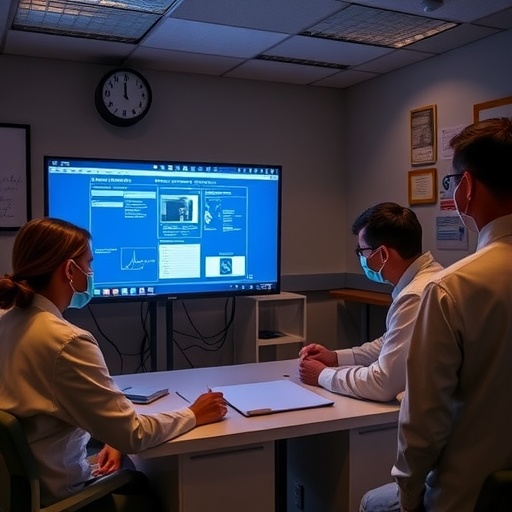Researchers at UCL find reduced social preference in isolated zebrafish is caused by stress and anxiety, not observed anti-social patterns.

Credit: Tunbak et al 2020
London, 10 June 2020 – Over the past few months at least half of the world’s population has been affected by some form of lockdown due to COVID-19, and many of us are experiencing the impact of social isolation. Loneliness affects both mental and physical health, but counterintuitively it can also result in a decreased desire for social interaction. To understand the mechanics of this paradox, UCL researchers based at the Wolfson Institute and the Sainsbury Wellcome Centre investigated social behaviour in zebrafish. Their results are published in eLife.
Most zebrafish demonstrate pro-social behaviour, but approximately 10% are ‘loner’ fish who are averse to social cues and demonstrate different brain activity than their pro-social siblings. However, even typically social zebrafish avoid social interaction after a period of isolation. PhD students Hande Tunbak and Mireya Vazquez-Prada, Postdoctoral Research Fellow Thomas Ryan, Dr Adam Kampff and Sir Henry Dale Wellcome Fellow Elena Dreosti set out to test whether the brain activity of isolated zebrafish mimics that of loner fish or whether other forces were at play.
To investigate the effects of isolation, the researchers isolated typically social zebrafish from other fish for a period of two days and then compared their brain activity to zebrafish who demonstrated aversion to social interaction without having been isolated. The isolated fish demonstrated sensitivity to stimuli and had increased activity in brain regions related to stress and anxiety. These effects of isolation were quickly overcome when the fish received a drug that reduces anxiety.
The differences between loner fish and their siblings were found mostly in the hypothalamus, the region of the brain responsible for social rewards. The loner fish hypothalamus did not demonstrate the same pattern of activation during social exposure as its typical counterparts, indicating that loner fish do not experience rewards in the same way as typical fish during social interactions.
By contrast, ‘lonely’ fish–those that demonstrated typical social behaviour and were isolated–demonstrated hypersensitivity to stimuli and activation of brain regions associated with stress and anxiety. Lonely fish experienced actively negative outcomes from social interaction whereas loner fish simply did not experience reward.
“A detailed view of the zebrafish brain can provide important clues for all of us currently experiencing the effects of social isolation,” says Dr Elena Dreosti. Our understanding of the neural mechanisms of social behaviour are limited, but we do know that zebrafish and humans share a fundamental drive for social interaction that is controlled by similar brain structures. Although human behaviour is much more complex, understanding how this basic social drive arises–and how it is affected by isolation–is a necessary step towards understanding the impact of the social environment on human brains and behaviour. The zebrafish, which is completely transparent throughout early development, offers neuroscientists a detailed view of its brain circuitry.
We won’t all be loners after lockdown, but we will be anxious upon returning to our normal social lives. As we emerge from lockdown, we should be aware of this new sensitivity and anxiety, but recognise that overcoming it is necessary for returning to a normal, healthy, social existence.
###
Read the full paper in eLife. https:/
DOI: 10.7554/eLife.55863
Contact: Hallie Detrick [email protected]
Communications Manager, Sainsbury Wellcome Centre, UCL
About UCL – London’s Global University
UCL is a diverse community with the freedom to challenge and think differently.
Our community of more than 41,500 students from 150 countries and over 12,500 staff pursues academic excellence, breaks boundaries and makes a positive impact on real world problems.
We are consistently ranked among the top 10 universities in the world and are one of only a handful of institutions rated as having the strongest academic reputation and the broadest research impact.
We have a progressive and integrated approach to our teaching and research – championing innovation, creativity and cross-disciplinary working. We teach our students how to think, not what to think, and see them as partners, collaborators and contributors.
For almost 200 years, we are proud to have opened higher education to students from a wide range of backgrounds and to change the way we create and share knowledge.
We were the first in England to welcome women to university education and that courageous attitude and disruptive spirit is still alive today. We are UCL.
http://www.
Find out how UCL is helping lead the global fight against COVID-19 http://www.
About the Wolfson Institute
The Wolfson Institute for Biomedical Research (WIBR) was established at UCL in 1995 for the pursuit of excellence in translational biomedical research. A member of the Division of Medicine, the department’s primary focus is on excellence in basic neuroscience research and its application to mental health and disease. The WIBR is a key hub within the rich environment of the UCL neuroscience community.
About the Sainsbury Wellcome Centre
The Sainsbury Wellcome Centre (SWC) brings together outstanding experimental neuroscientists who work closely with theorists at the Gatsby Computational Neuroscience Unit (GCNU) to generate and test conceptual frameworks that explain how neural circuits give rise to the fundamental processes underpinning adaptive, flexible behaviour, including perception, memory, expectation, cognition, decisions and action.
The SWC fosters dialogue and collaboration between neuroscientists from within UCL and beyond. Our research environment, international PhD programme, and specialised courses in experimental and computational techniques are designed to equip the next generation of neuroscientists with the knowledge and tools to tackle the big questions in neuroscience.
Media Contact
Hallie Detrick
[email protected]
Original Source
https:/
Related Journal Article
http://dx.





